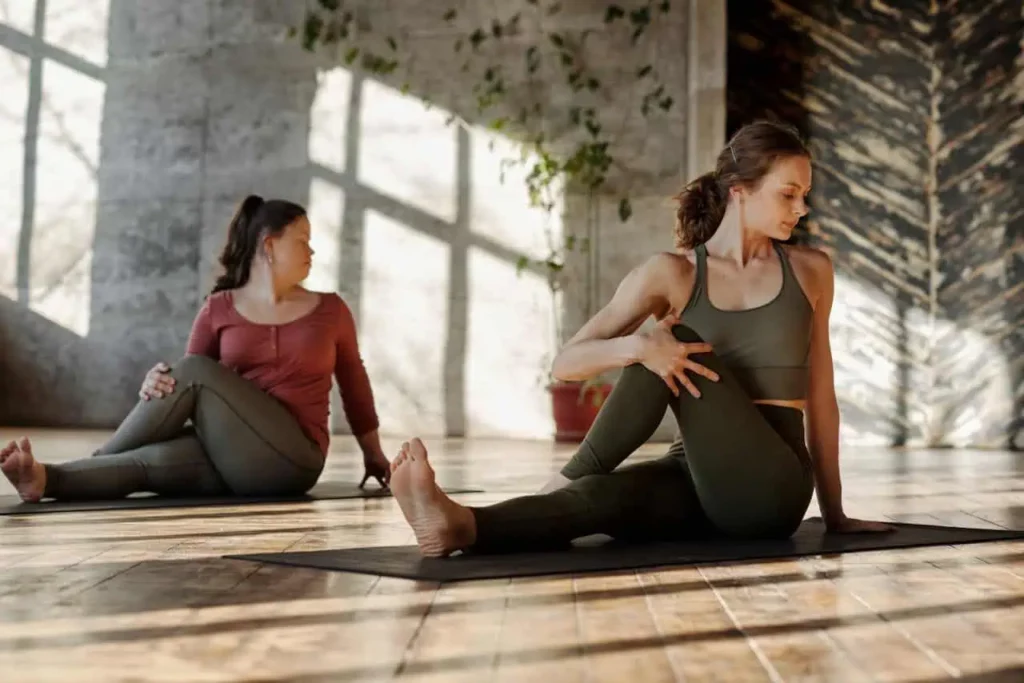Last Updated on June 8, 2024
Stretching is a fundamental aspect of physical fitness and wellness that has numerous benefits for the body, including improved flexibility and increased range of motion. Stretching involves the deliberate lengthening of muscles, tendons, and ligaments to reduce stiffness and enhance mobility.
Depending on your fitness level, health goals, and the specific physical demands of your favorite activities, different types of stretches can be utilized to warm up the body, aid in recovery, and improve performance.
There are various stretching techniques. Selecting the correct technique can depend on your desired outcome, whether it be injury prevention, increased athletic performance, or general flexibility.
It’s important to approach stretching with an understanding of one’s own body and its limits. Incorporating a safe and effective stretching routine into one’s regular routine not only supports muscular health but contributes to overall well-being.
Key Takeaways
- Stretching enhances flexibility and range of motion which reduces pain and improves everyday movements.
- Specific types of stretches can be used to achieve different health goals.
- When incorporated correctly a stretching routine can prevent injury and improve wellness.
Understanding Stretching
Stretching and flexibility is one of the three important pillars of good physical health. The others are strength and cardio health. When all three of these pillars are in balance we move easily and feel strong and healthy.
If we are too strong and lack flexibility we are prone to injury. Similarly, if we are too flexible and lack strength we are also prone to injury.
Understanding the underlying physiological principles of stretching and performing the correct stretches in the right way will optimize the benefits and minimize the risk of injury.
Targeting muscles that are shortened helps improve posture and function. For instance, many of us have shortened chest muscles from computer work. Doorway stretches help to open the chest and alleviate shoulder pain.
Benefits of Stretching
Regular stretching improves joint range of motion, facilitates better posture, and helps alleviate muscle tension. When incorporated into a workout regimen, stretching will also reduce the risk of injuries and aid in recovery post-exercise.
Types of Stretching
- Dynamic Stretches: These involve moving parts of the body through their full range of motion to prepare the muscles for vigorous activities. Examples include leg swings and arm circles.
- Static Stretching: Holding a stretch for a prolonged period, usually 15-30 seconds, allows muscles to lengthen and relax, often performed post-exercise.
- PNF Stretching: Proprioceptive Neuromuscular Facilitation is a more advanced form of flexibility training that involves activating the muscles during the stretch.
- Isometric Stretching: This technique involves the resistance of muscle groups through isometric contractions (tensing the muscle without movement).
- Ballistic Stretching: Involves ‘bouncing’ movements to push the body beyond its normal range of motion, which can be risky and is not commonly recommended.
- Passive Stretching: Requires the aid of an external force, such as a stretching device or a partner, to hold the body in a stretch.
- Active Stretching: The individual uses the strength of their agonist muscles to hold a stretch without any external support.
Physiology of Stretching
The physiology of stretching involves complex communication between the neurological and musculoskeletal systems.
One component of stretching involves the feedback from muscle spindle fibers. Muscle spindles are specialized sensory neurons. These neurons reside within muscles. When a muscle stretches these spindle fibers cause the muscle to contract reflexively, known as the stretch reflex.
Proper stretching techniques allow this reflex to calm and reset the length of the muscle at which the reflex is triggered. Basically with regular stretching we can reset the position that our nervous systems sees as normal.
If we have spent years hunched over a desk, our nervous system will come to see that hunched position as normal. By stretching the chest we allow the nervous system to reset what it sees as normal to a much healthier position. In the case of the chest, this can impact how we breathe and sleep thus having huge health benefits!
Over time, consistent stretching can lead to increased muscle length and improved flexibility, enhancing one’s ability to perform both everyday and specialized movements with greater ease and less strain.
Stretching Techniques
Stretching correctly is crucial to prevent injury while stretching. If in doubt, talk to a physician, a yoga instructor or someone versed in proper stretching. Learning to stretch properly will reduce the risk of injury.
Always listen to your body! If it feels wrong for you it’s probably wrong for you.
Proper Breathing
Breathing is an important aspect of stretching. It relaxes the nervous system and allows the muscles to lengthen. It also improves oxygenation of the blood while stretching.
Practice with a slow steady breath into the abdomen. Inhale deeply through the nose to fill the lungs and exhale through the mouth or nose.
Position and Posture
Proper positioning and posture are essential to target the correct muscle groups and to prevent strain or injury. If stretching are performed incorrectly it can put strain on structures like ligaments and tendons instead of allowing the stretch to transfer directly to the muscles.
We also want to reinforce good posture while stretching. Remember we’re retraining the nervous system to read our body position.
For example, in a pec stretch, keeping the spine upright and long and the head aligned over the shoulders will specifically target the pecs.
Control and Consistency
Control and consistency are key factors in safely stretching and enhancing flexibility.
It is crucial to perform stretches regularly and to be in control throughout the movement. Don’t fall into a position with too much weight on vulnerable structures. Allow time to help you achieve deeper stretches. It can take weeks, months, and even years to achieve some of the deep stretches you see on the internet.
Stretching puts muscles into lengthened positions. Muscles are more vulnerable to injury and tearing in these vulnerable positions. Approach stretching with caution and awareness.
Always listen to your body! If it feels wrong for you it’s probably wrong for you.
Stretching for Different Goals
Different stretching techniques can significantly enhance sports performance, aid in injury prevention and rehabilitation, and promote overall health and wellness.
Each goal necessitates specific stretching strategies to achieve optimal results.
- Dynamic Stretches: These should be used for warm-up.
- Static Stretching: These are more commonly employed after a workout.
- PNF Stretching: These can be used for rehabilitation post-injury or if significant increases in range of motion are the goal.
- Isometric Stretching: These are great post-injury as the range of motion required is minimal.
- Ballistic Stretching: These are best avoided unless you have circus aspirations!
- Passive Stretching: These are great if you have experienced friends and find that social activities keep you motivated.
For athletes, incorporating stretches that focus on performance enhancement is important as is balancing out the muscle groups that are strongly developed by their specific sport. For example, many runners have shortened quad muscles. Targeting these muscles will have more benefit than stretching the neck.
Injury Prevention and Rehabilitation
As we discussed above, having balanced, well-positioned muscles will prevent injury. When muscles are shortened and posture is poor we have elongated tendons, muscles, and ligaments that are more prone to injury.
For example, shoulder impingement syndrome is often caused by a forward shoulder and a twisting of the supraspinatus tendon. When this picture is present simple home activities like working in the yard can lead to injury.

Targeted Stretching
Targeted stretching focuses on isolating and mobilizing specific muscle groups to improve flexibility, increase range of motion, and reduce muscle tension. This form of stretching is often used to address muscle imbalances and to aid in recovery from injuries.
With the help of a qualified clinician, you can identify imbalanced muscle groups. Quad and hamstrings are a common pair. Often over overdeveloped and shortened quads will lead to hamstring pain. However, stretching the hamstrings is the wrong response. In this scenario, the quads need to be stretched and the hamstrings need to be strengthened.
Basic Upper Body Stretches
For the shoulders, an effective targeted stretch is the cross-body arm stretch, which involves bringing one arm across the body and using the opposite hand to pull the arm closer, thereby stretching the shoulder.

For the chest, the door-frame stretch, where one stands in a doorway with arms bent at 90 degrees to press against the door frame, can open up the pectoral muscles effectively.
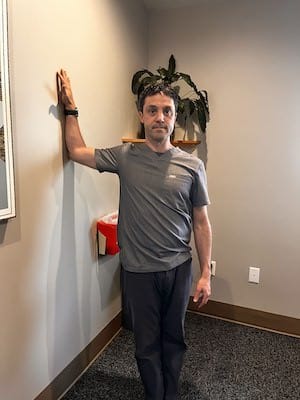
Basic Lower Body Stretches
For the hamstrings, sit on the floor with your legs extended and reach forward towards the toes.

For the quadriceps, a common stretch is pulling the heel towards the glutes while standing, holding onto support for balance if necessary.
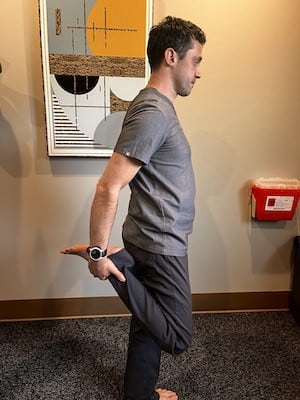
The hips and glutes can be targeted through stretches such as the pigeon pose, which helps to relieve tightness in the hip flexors and the piriformis muscle.
Core and Back Stretches
The core muscles, particularly the abs and lower back, are integral to overall stability and posture.
A well-known stretch for the lower back is the child’s pose, where one sits on the heels with arms stretched forward on the ground, which helps in releasing tension in the lower back region.
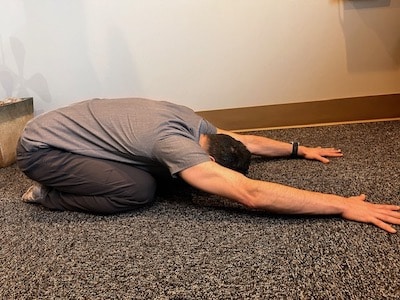
To focus on the abs, lying on one’s stomach and gently lifting the upper body while keeping the hips grounded—known as the cobra pose—can stretch the abdominal muscles.
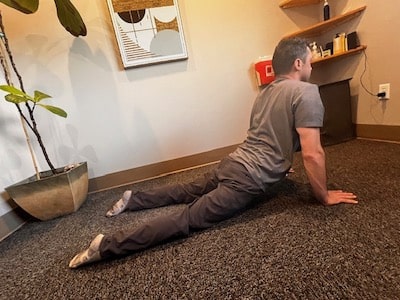
It is essential to approach core stretches with care to avoid hyperextension and potential injury.
Common Mistakes and Risks
Overstretching is a common mistake that can result in significant muscle strain and damage. Stretching beyond your current level of flexibility, will increase your risk of causing damage to muscles and tendons.
Consistently pushing past a comfortable range of motion can lead to injury.
A few keys for staying safe. :
- Start with a gentle warm-up to prepare muscles and generate some blood flow.
- Focus on control, and never fall into or bounce through a stretch.
- Maintain deep controlled breathing, this keeps you aware and in control.
Consulting Healthcare Professionals
Before starting any new stretching regimen, consulting professionals such as yoga instructors, chiropractors or acupuncturists is prudent.
They provide tailored advice that can help safely improve flexibility and mitigate the risk of injuries.
Moreover, they can offer specific strategies for your body. A little assessment and evaluation can go a long way toward improving the benefits you see from a stretching routine.
Incorporating Stretching into Lifestyle
Many people adopt morning stretching routines. This allows the body to elongate after sleeping and prepare the body for the day.
For others, an evening routine fits better into their lifestyle. This counteracts the stresses of the day and prepares the nervous system for a great sleep. These stretches are often less vigorous.
Another strategy is simply finding moments throughout the day for brief stretches. You could use the doorway stretch to alleviate stress from prolonged sitting at a desk.
Scientific Research and Studies
Scientific examination has consistently refined our understanding of stretching and its effects on the body, particularly concerning injury prevention, performance, and physiological responses such as blood flow and joint health.
Researchers and entities like the American College of Sports Medicine continue to publish findings that guide best practices.
Recent Advances in Stretching
Recent studies underscore the complexity of stretching and its impact on athletes’ performance and the general population’s health.
Research indicates that dynamic stretching can enhance subsequent performance by improving blood flow and increasing muscle temperature.
On the other hand, static stretching has been shown to potentially reduce strength in the short term if performed before high-intensity activities.
A notable study, To stretch or not to stretch, highlights the subjective nature of stretch intensity and its threshold for discomfort without reaching a level of pain, guiding readers through the benefits and potential drawbacks.
Studies that focused on specific stretch durations have provided insights into how long individuals should stretch to maximize benefits.
The relationship between different types of stretching and their optimal durations is captured in the study on The relation between stretching typology and stretching duration. This study examined the effects of long-term interventions, suggesting tailored strategies for various fitness and rehabilitation goals.
Expert Opinions and Guidelines
Experts including those affiliated with the American College of Sports Medicine have established guidelines advocating for a balanced view of stretching that incorporates a range of techniques.
Their recommendations aim to optimize joint health and overall physiological function.
While some maintain that stretches should be a routine part of exercise to improve flexibility and reduce injury risk, others advise a more nuanced application, particularly about athletic performance.
Recognition of the importance of individualized approaches for stretching routines has grown.
An exploration into Stretching to reduce work-related musculoskeletal disorders suggests the need for further study before definitive stretching protocols can be universally prescribed, especially in occupational settings.
The evidence base concerning stretching remains diverse, with ongoing research clarifying the stance of stretching within different contexts and populations.
Stretching Myths and Misconceptions
In addressing stretching myths and misconceptions, it’s good to differentiate between outdated beliefs and evidence-based practices to optimize the benefits of stretching.
Debunking Stretching Myths
Myth: Stretching before exercise prevents injuries.
Fact: Stretching has not been conclusively proven to prevent injuries.
Some research suggests that dynamic stretching can be beneficial for warming up muscles, but traditional static stretching before exercise might not yield the injury-prevention benefits once believed.
Myth: You should hold a stretch for at least 30 seconds to benefit.
Fact: The optimal duration for a stretch can vary depending on the goal.
Scientific consensus suggests that holding a stretch for 30 seconds is ideal for increasing muscle length.
Clarifying Common Confusions
Confusion: Stretching and warming up are the same.
Clarification: Stretching is a component of warming up, but an effective warm-up often includes cardiovascular activities to increase heart rate and blood flow, along with dynamic stretching.
Confusion: All types of stretching have the same effect.
Clarification: Different types of stretches – such as static, dynamic, ballistic, and proprioceptive neuromuscular facilitation (PNF) – have varying effects.
They should be utilized according to an individual’s specific fitness goals.
Frequently Asked Questions
In this section, we address common inquiries regarding stretching methods and their implications for flexibility, muscle performance, and athletic enhancement, based on established practices in physical therapy and exercise routines.
What are the different methods of dynamic stretching for improving flexibility?
Dynamic stretching involves moving parts of the body gradually increasing reach, speed of movement, or both, to improve flexibility.
Techniques include leg swings, arm circles, and torso twists, which can be beneficial for warming up before physical activity.
How does static stretching affect muscle performance?
Static stretching can lead to temporary decreases in muscle strength, power, and performance if done before activities requiring maximal force.
It is often more effective when performed after exercise, as it helps muscles relax and elongate, contributing to overall flexibility.
What are some examples of ballistic stretching exercises?
Ballistic stretching exercises use the momentum of a moving body or a limb in an attempt to force it beyond its normal range of motion.
Examples include bouncing while touching the toes, or the “butterfly” stretch where one flaps the legs to push the knees toward the floor.
Can you list four types of stretching exercises that enhance athletic performance?
Stretching exercises known to benefit athletic performance include plyometric drills, sport-specific dynamic stretches, myofascial release techniques, and proprioceptive neuromuscular facilitation (PNF).
These methods can improve flexibility, strength, and neuromuscular coordination.
What are three common stretching techniques used in physical therapy?
Physical therapy often employs stretching techniques like passive stretching, where a therapist helps extend a muscle, active stretching, where the individual engages the muscles to hold a stretch, and PNF stretching, which combines passive movements and active muscle contractions.
How can static stretching routines be integrated into a regular workout plan for better results?
Integrating static stretching at the end of a workout can be beneficial. Holding stretches for 15-30 seconds for each major muscle group can enhance flexibility and reduce muscle tension accumulated during the workout.

